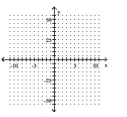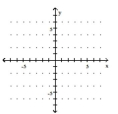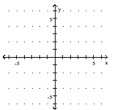A)
B)
C)
D)
Correct Answer

verified
Correct Answer
verified
Multiple Choice
Find all the rational zeros of the function. -
A) -2, -1, 1
B) -2, 2
C) 2, -1, 1
D) -1, 1
Correct Answer

verified
Correct Answer
verified
Multiple Choice
Graph the polynomial function.
-

A) ![]()
B) ![]()
C) ![]()
D) ![]()
Correct Answer

verified
Correct Answer
verified
Multiple Choice
Use Descartes' Rule of Signs to determine the possible number of positive and negative real zeros for the polynomial function. -
A) 2 or 0 positive zeros, 2 or 0 negative zeros
B) 3 or 1 positive zeros, 3 or 1 negative zeros
C) 2 or 0 positive zeros, 1 or 0 negative zeros
D) 2 or 0 positive zeros, 1 negative zero
Correct Answer

verified
Correct Answer
verified
Multiple Choice
Find all real zeros (estimate the irrational zeros to the nearest hundredth) . -
A) -6, -2.24, 2.24
B) -6
C) 5.48, 6
D) -30
Correct Answer

verified
Correct Answer
verified
Multiple Choice
Graph the polynomial function.
-

A) ![]()
B) ![]()
C) ![]()
D) ![]()
Correct Answer

verified
Correct Answer
verified
Multiple Choice
Find all the rational zeros of the function. -
A) -3
B) -2
C) -2, 2, 3
D) -3, -2, 2
Correct Answer

verified
Correct Answer
verified
Multiple Choice
Classify the function as continuous or discontinuous. If the function is not continuous, identify the point(s) of discontinuity. -
A) discontinuous at x = . . . -3, -2, -1, 0, 1, 2, 3, . . .
B) continuous
C)
D) discontinuous at x = . . . -9, -6, -3, 0, 3, 6, 9, . . .
Correct Answer

verified
Correct Answer
verified
Multiple Choice
Find all the rational zeros of the function. -
A)
B)
C)
D)
Correct Answer

verified
Correct Answer
verified
Multiple Choice
Graph the rational function.
-

A) ![]()
B) ![]()
C) ![]()
D) ![]()
Correct Answer

verified
Correct Answer
verified
Multiple Choice
Find all points of discontinuity, and determine whether there is a hole or a vertical asymptote at each point. -
A) -5: vertical asymptote
B) 0: vertical asymptote; 5: vertical asymptote
C) 0: vertical asymptote; -5: vertical asymptote
D) no vertical asymptotes
Correct Answer

verified
Correct Answer
verified
Multiple Choice
Classify the function as continuous or discontinuous. If the function is not continuous, identify the point(s) of discontinuity. -
A) discontinuous at x = 2 and x = 6
B) discontinuous at x = -2 and x = -6
C) continuous
D)
Correct Answer

verified
Correct Answer
verified
Multiple Choice
Find the x-intercepts of the function. -
A) x-intercept: (0, 0) , x-intercept: (- 6, 0) , x-intercept: (5, 0)
B) x-intercept: (4, 0) , x-intercept: (5, 0)
C) x-intercept: (- 6, 0) , x-intercept: (5, 0)
D) x-intercept: (0, 0) , x-intercept: (4, 0) , x-intercept: (5, 0)
Correct Answer

verified
Correct Answer
verified
Multiple Choice
Determine whether the graph of the rational function has a horizontal asymptote, an oblique asymptote, or neither. Give the equation of the asymptote if it exists. -
A) Oblique asymptote: y = x - 8
B) Horizontal asymptote: y = 1
C) Neither
Correct Answer

verified
Correct Answer
verified
Multiple Choice
Determine whether the function is an even function, an odd function, or neither. -
A) Odd
B) Neither
C) Even
Correct Answer

verified
Correct Answer
verified
Multiple Choice
Find the real zeros of the function, state their multiplicities if it is a number other than 1. -
A) x = 5, multiplicity: 2
B)
C) x = -5, multiplicity: 2
D) x = 5, x = -5
Correct Answer

verified
Correct Answer
verified
Multiple Choice
Determine whether the function is an even function, an odd function, or neither. -
A) Odd
B) Neither
C) Even
Correct Answer

verified
Correct Answer
verified
Multiple Choice
Graph the greatest integer function.
-

A) ![]()
B) ![]()
C) ![]()
D) ![]()
Correct Answer

verified
Correct Answer
verified
Multiple Choice
Determine which of the given graphs could be the graph of the given polynomial function. -
A) ![]()
B) ![]()
C) ![]()
D) ![]()
Correct Answer

verified
Correct Answer
verified
Multiple Choice
Use the Intermediate Value Theorem to determine if a real zero of f(x) occurs in the given interval. If this cannot be determined, indicate so. -
A) Cannot determine
B) Yes
Correct Answer

verified
Correct Answer
verified
Showing 61 - 80 of 142
Related Exams